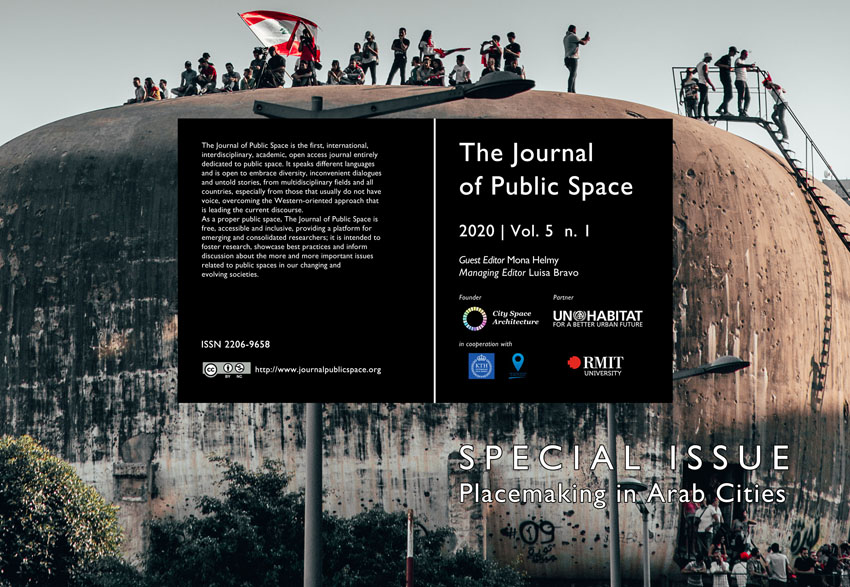Prospects of Placemaking Progression in Arab cities
##plugins.themes.bootstrap3.article.main##
Abstract
Placemaking is a philosophical ideology that focuses on common and shared values among the different stakeholders aiming at providing better environment for the people. It is a hands-on tool that increases place attachment and yields places that reflect the local identities of the people and so transforms them into active players and local guardians. Several typologies of placemaking emerged overtime, but they are all people driven. On the contrary to public projects ideologies which are not certainly to be people driven at all times. In this regard, the research aims at investigating the different set ups in the Arab region in relation to placemaking philosophy. The study is discussing the two cases of Abu Dhabi and Cairo as two diverse contexts in the Arab region with different inputs and challenges. Despite the potentials revealed for the progression of placemaking in the two studied cities, the research argues that achieving the core philosophy of placemaking is still early in the Arab region. As it requires core and in-depth consideration of public realm production ideologies and its subsequent administrative set ups that would encourage inclusive and democratic process.
##plugins.themes.bootstrap3.article.details##
The Authors retain copyright for articles published in The Journal of Public Space, with first publication rights granted to the journal.
Articles in this journal are published under the Creative Commons Attribution NonCommercial Licence (CC-BY-NC) - https://creativecommons.org/licenses/by-nc/4.0/.
You are free to:
• Share - copy and redistribute the material in any medium or format
• Adapt - remix, transform, and build upon the material
Under the following terms:
• Attribution - You must give appropriate credit, provide a link to the license, and indicate if changes were made. You may do so in any reasonable manner, but not in any way that suggests the licensor endorses you or your use.
• NonCommercial — You may not use the material for commercial purposes.
References
Abdelhalim, A. I. (1996). Culture, Environment, and Sustainability: Theoretical Notes and Reflection on A Community Park Project In Cairo. In: W. O’Reilly, ed. Sustainable Landscape Design in Arid Climates. Geneva, Switzerland: Aga Khan Trust for Culture.
Abu Dhabi Urban Planning Council (2011). Abu Dhabi Public Realm Design Manual, Abu Dhabi - UAE: Abu Dhabi Urban Planning Council.
Abu Dhabi Urban Planning Council (2017). Abu Dhabi Open Space Framework, Abu Dhabi: Abu Dhabi Urban Planning Council.
Agyeman, J. (2013). Introducing just sustainabilities. Policy, Planning, and Practice. London, UK : Zed books.
Alarab (2015). «هنلونها».. حملة شبابية تعيد البهجة إلى ميادين مصر. [Online] [Accessed 17 July 2018].
Austin, G. (2014). Green infrastructure for landscape planning – integrating human and natural systems. Oxon and New York: Routledge.
Cluster (2013). Cairo Downtown Passages – Kodak Passage. [Online] Available at: http://clustercairo.org/cluster/design/cairo-downtown-passages-kodak-passage [Accessed 15 March 2018].
De Koning, A. (2005). Global dreams : space, class and gender in middle class Cairo, Amsterdam: University of Amsterdam.
Dempsey, N. & Burton, M. (2011). Defining place-keeping: The long-term management of public spaces.. Urban Forestry & Urban Greening, 11(1), pp. 11-20.
Egypt Economic Development Conference (2015). Sustainable Development Strategy: Egypt’s Vision 2030, Sharm El Sheikh: Egypt Economic Development Conference.
El Shahed, S. (2014). Coloring Cairo: Artists on quest to paint city’s satellite dishes. [Online] [Accessed 17 July 2018].
Environment Agency - Abu Dhabi, n.d. ENVIRONMENT Vision 2030, Abu Dhabi: Environment Agency - Abu Dhabi.
Fahmi, W. & Sutton, K. (2008). Greater Cairo’s housing crisis: Contested spaces from inner city areas to new communities. Cities, Volume 25, pp. 277–297.
Future City Group (2012). Place Makers Toolkit - The City of Newcastle, Newcastle : The City of Newcastle.
GOPP, UN-Habitat & UNDP (2012). Greater Cairo (GC) Urban Development Strategy, Cairo: Ministry of Housing, Utilities, and Urban Communities.
Hassan, N. M. (1984). Social Aspects of Urban Housing in Cairo. Cairo: based on a presentation made in an Aga Khan Award for Architecture Seminar on "The Expanding Metropolis" held in Cairo.
Ibrahim, A. A. A. M. & Amin, A. (2014). Participatory Landscape Design of New Cities in Egypt: Correlation Model of Related Variables, Case of 6th of October City. Journal of Urban Planning and Development, 141(4).
Khaled, R. (2014). Colouring Egypt’s grey cities. [Online] [Accessed 17 July 2018].
Kramer, M. G., 2014. ENHANCING SUSTAINABLE COMMUNITIES WITH GREEN INFRASTRUCTURE, U.S. Environmental Protection Agency’s Office of Sustainable Communities.
Land Use Consultants (LUC) (2009). Natural England’s Green Infrastructure Guidance, Natural England.
Local Government Association (2017). People, culture, place - The role of culture in placemaking, London: Local Government Association.
Mehaffy, M. W., Elmlund, P. & Farrell, K. (2018). Implementing the New Urban Agenda: the central role of public space. Urban Design International, 24(1), pp. 4-6.
Michigan State University Land Policy Institute (2015). Placemaking Assessment Tool, Michigan.
Mohamed, A. A., (2015). Lessons From Cairo: How Small Scale Urban Initiatives can Improve a City. [Online] [Accessed 17 July 2018].
Najafi, M. & Shariff, M. K. B. M. (2011). The Concept of Place and Sense of Place In Architectural Studies. International Journal of Humanities and Social Sciences, 5(8), pp. 1054-1060.
Project for Public Spaces (PPS) (2012). Placemaking and the Future of Cities, UN-HABITAT, Sustainable Urban Development Network (SUD-Net).
Project for Public Spaces (PPS) (2018). PLACEMAKING. What if we built our cities around places?, Project for Public Spaces (online).
Relph, E. (1976) [reprinted 2008]. Place and place lessness. 2nd ed. London : pion limited.
Scottish Natural Heritage (2012). Better places for people and nature, Scotland: www.snh.gov.uk.
Selim, G. (2016). Unfinished Places: The Politics of (Re)making Cairo’s Old Quarters. Taylor & Francis.
Tewfik, I. (1996). Case Study: Mobilization in a Cairo Neighborhood. Community Participation and Environmental Change. Middle East Report, n. 202, pp. 26–27.
UN-Habitat (2011). Cairo – a city in transition. 1st ed., UN Habitat.

